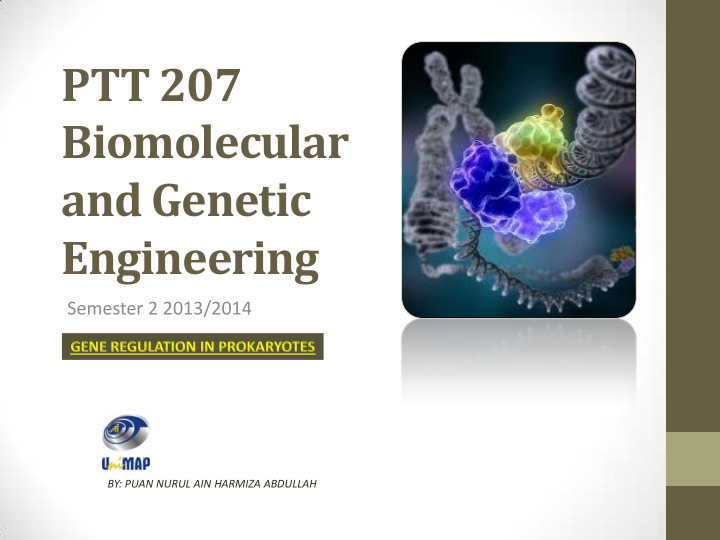



PTT 207 Biomolecular and Genetic Engineering Semester 2 2013/2014 BY: PUAN NURUL AIN HARMIZA ABDULLAH
How do bacteria adapt so quickly to their environments? Part of the answer to this question lies in clusters of co-regulated genes called operons.
INTRODUCTION • Bacteria are typically exposed to an ever- changing environment in which nutrient availability may increase or decrease radically. • Bacteria respond to such variations in their environment by altering their gene expression pattern ; thus, they express different enzymes depending on the carbon sources and other nutrients available to them.
INTRODUCTION • It would be wasteful to synthesize, for example, lactose-metabolizing enzymes in the absence of lactose. • However, when lactose is the only available carbon source, bacteria must quickly induce lactose-metabolizing enzymes, or else they will die. • In bacteria, this sort of genetic regulation is mediated at the level of transcription .
Bacterial Operons Are Co- regulated Gene Clusters • Bacterial genes are organized into clusters of co- regulated genes (or operons). • These genes are regulated such that they are all turned on or off together. • Grouping related genes under a common control mechanism allows bacteria to rapidly adapt to changes in the environment.
Bacterial Operons Are Co- regulated Gene Clusters • The best-studied examples of operons are from the bacterium Escherichia coli (E. coli), and they involve the enzymes of lactose metabolism and tryptophan biosynthesis. • Because the lactose (lac) operon shares many features with other operons, its organization and regulation are described in detail next.
Regulation of Gene Expression in Prokaryotes and Eukaryotes • Clever mechanisms turn genes off and on so that they only function when there is a need for their services.
Prokaryotes and the Operon Model • Prokaryotes have two levels of gene control. • Transcriptional mechanisms control the synthesis of mRNA . • Translational mechanisms control the synthesis of protein after mRNA has been produced.
THE OPERON • Operons contain groups of genes that are regulated together. There are two different kinds of genes in operons: • Structural genes code for proteins needed for the normal operation of the cell. For example, they may be proteins needed for the breakdown of sugars. The structural genes are grouped together and a single mRNA molecule is produced during their transcription. • Regulator genes code for proteins that regulate other genes. • Operons are found mostly in prokaryotes
TYPES OF OPERON 1. The lac operon 2. The trp Operon
THE LAC OPERON • Lactose is a sugar found in milk. • If lactose is present, E. coli (the common intestinal bacterium) needs to produce the necessary enzymes to digest it.
THE LAC OPERON • Is an example of an inducible system . • Always turned off unless an inducer (lactose) is available. • In inducible system, a substance from environment (the inducer) interacts with the regulatory gene product (repressor), rendering it incapable of binding to the operator and thus incapable of blocking transcription.
THE LAC OPERON The lac operon consists of 3 genes: lacZ – encodes β -galactosidase. – cleave lactose into galactose + glucose = ENERGY lacY – encodes lactose permease. – transport β -galactosidase ( lactose) into the cell. lacA – encodes transacetylase. – remove thio-galactosidases (cell toxin) that get taken up by the permease.
Some humans cannot digest it (lactose intolerance). In fact, the ability to digest lactose was actually a mutation! When it passes through the digestive tract undigested it empties from the small intestine to the large intestine's cecum. There, gut flora (microorganisms) ferment lactose and other carbohydrates for energy. E.Coli is one of the many microorganisms that live in our large intestine. It, and the others, ferment lactose (among other things) for energy. So long as glucose is present, operons such as lactose are not transcribed efficiently. Only after http://highered.mcgraw- exhausting supply of glucose does hill.com/sites/dl/free/0072835125/126997/animation27.html the bacterium fully turn on http://www.sumanasinc.com/webcontent/animations/content/lacoperon.html expression of the lac operon.
THE TRYPTOPHAN OPERON • Is an example of a repressible system . • Always expressed unless the compressor (trp) available. • In repressible system, a substance in the cell (the compressor) interacts with the regulatory gene product to make it capable of binding to the operator and blocking transcription.
THE TRYPTOPHAN OPERON
http://bcs.whfreeman.com/thelifewire/content/chp13/1302002.html
PTT 207 Biomolecular and Genetic Engineering Semester 2 2013/2014 BY: PUAN NURUL AIN HARMIZA ABDULLAH
INTRODUCTION • Most of the control of gene expression in eukaryotes is achieved by regulating the frequency of transcription initiation.
http://highered.mcgraw- hill.com/sites/9834092339/student_view0/chapter16/control_of_gene_expression_in_e ukaryotes.html
Eukaryotes: Multiple Models of Gene Regulation • Transcription Initiation • Efficient binding of RNA pol increases the rate of transcription initiation. • Exon Splicing • The faster mRNA is processed, the greater amount of gene product. • Passage through the Nuclear Membrane • Control access to/efficient of transport channel. • mRNA Destruction • Control the rate of degradation. • Translational Control (Protein synthesis) • Speeding up of slowing down the synthesis. • Post-translational modification • Phosphorylation can alter protein activity.
Gene Regulation Is Necessary? • By switching genes off when they are not needed, cells can prevent resources from being wasted. There should be natural selection favoring the ability to switch genes on and off. • Complex multicellular organisms are produced by cells that switch genes on and off during development. • A typical human cell normally expresses about 3% to 5% of its genes at any given time. • Cancer results from genes that do not turn off properly. Cancer cells have lost their ability to regulate mitosis, resulting in uncontrolled cell division.
The End Thank You
Recommend
More recommend